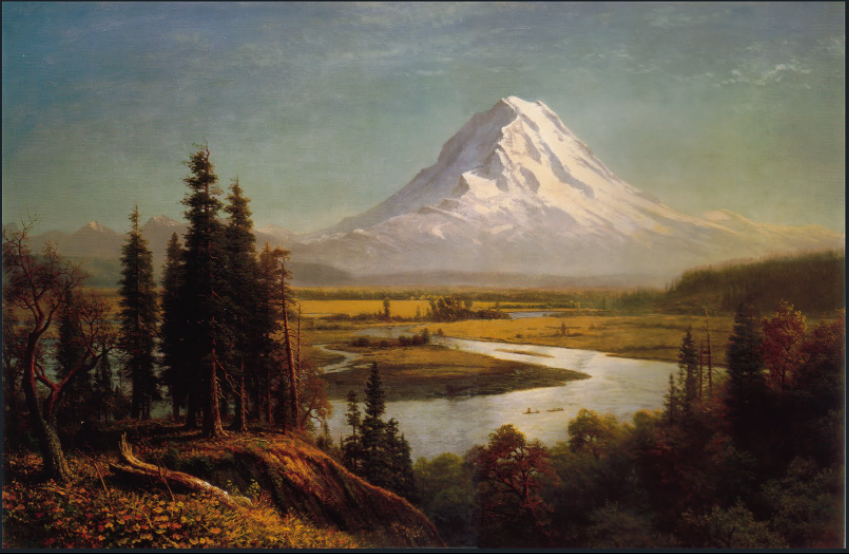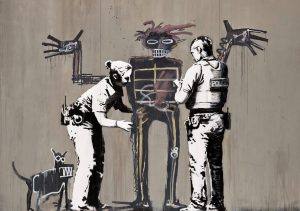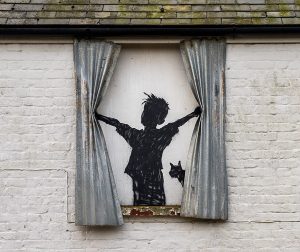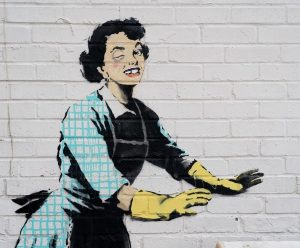
Subject to Availability, 2009
Oil on canvas in artist’s frame
159.5 x 220.3 cm (62 3/4 x 86 3/4 inches)
Unique
Signed “Banksy”, lower left
Titled and inscribed “* Subject to availability for a limited period only”, lower right
Further signed and dated “BANKSY 2009/2010” on the reverse
Christie’s London: 30 June 2021
GBP 4,582,500 / USD 6,350,000
Exhibited
Banksy vs. Bristol Museum, Bristol Museum, Bristol, 2009
Source: Christie’s
Witty, satirical and timely, Subject to Availability is an important work from Banksy’s celebrated series of vandalized oil paintings. Hijacking an 1890 painting of Mount Rainier in Seattle by the German American artist Albert Bierstadt, Banksy inserts an asterisk next to the dormant volcano at the center of the composition, captioning it ‘*subject to availability for a limited period only’.

Bierstadt was a leading member of the Hudson River School, who railed against the industrial revolution’s destruction of nature. Operating over a century later, Banksy updates the political commentary of his forebear: the sweeping panorama, suffused with Romantic heroism and grandeur, is reduced to a terminal commodity, poised on the brink of expiry. Painted in 2009—the year of the UN Climate Change Conference in Copenhagen—the work was included in Banksy’s legendary exhibition Banksy versus Bristol Museum, alongside his monumental Devolved Parliament. Its message was hauntingly prophetic: in February 2020, Mount Rainier National Park was forced into temporary closure due to extreme flooding and mudslides.
Humankind’s disregard for nature has long been a keen concern for Banksy, whose creations operate as a form of social commentary. Situated within a trajectory that extends from William Hogarth’s eighteenth-century satire to Grayson Perry’s ceramic vases, his works hold a mirror up to the world, frequently using humor as a means of speaking the truth to power. Over the years, Banksy has addressed a host of contemporary issues, including police brutality, knife crime, poverty, the Israeli-Palestinian conflict, Brexit, migration and—most recently—the COVID-19 pandemic. The environment is a recurring theme within this practice: in 2009, to mark the end of the Copenhagen conference, Banksy mocked climate change sceptics by painting the words ‘I don’t believe in global warming’ sinking into the water of Regent’s Canal in North London.

In 2018, he painted a mural on the corner of a garage in the Welsh town of Port Talbot—home to one of Europe’s largest steelworks plants—depicting a young boy breathing in ash from a flaming skip. In the present work, Banksy’s deliberate nod to the Romantic era—a period that glorified the sublime majesty of nature—serves to underscore the tragic reality latent in his asterisked quip.
Subject to Availability neatly juxtaposes environmental destruction and the vandalization of art. The latter has been a key element of Banksy’s practice for nearly two decades, fueled by a desire to liberate creative expression from the lofty bonds of institutional reverence. Having garnered attention as a police-dodging graffiti artist after moving from Bristol to London at the turn of the millennium, he embarked upon a series of pranks that brought the spirit of his urban interventions into the halls of galleries and museums. In 2003, he entered the Tate Britain in disguise, where he hung an artwork alongside a group of nineteenth-century landscapes. Titled Crimewatch UK Has Ruined The Countryside For All Of Us, it consisted of a pre-existing painting of a rural scene stenciled over with police incident tape. ‘This new acquisition is a beautiful example of the neo post-idiotic style’, ran Banksy’s gallery label. ‘… It can be argued that defacing such an idyllic scene reflects the way our nation has been vandalized by its obsession with crime.’ The painting hung undetected for two and a half hours, before crashing to the floor.

The Tate intervention set in motion a series of similar violations. In April 2004, a curious new species appeared in the Natural History Museum: a stuffed rat, with a can of spray paint at its feet, entitled ‘Banksus Militus Ratus’. ‘Attributed to an increase in junk food waste, ambient radiation and hardcore urban rap music,’ explained the text, ‘these creatures have evolved at an unprecedented rate.’ Later that year, a defamed version of the Mona Lisa sprung up at the Louvre—invoking Marcel Duchamp’s famous appropriation of the image—while March 2005 saw a sequence of four similar incidents at major museums in New York. That May, a slab of fake cave art confronted visitors at the British Museum: depicting a figure pushing a trolley, it was purportedly one of the few surviving pieces by ‘Banksyus Maximus’, whose works were largely ‘destroyed by zealous municipal officials who fail to recognize the artistic merit and historical value of daubing on walls.’ During the same year, Banksy mounted his seminal show Crude Oils in West London, where live rats swarmed among ‘re-mixed’ versions of famous masterworks. Monet’s serene lily pond became a commercial dumping ground, while van Gogh’s once-radiant sunflowers—now sourced from a petrol station—wilted and died in their vase.

Ultimately, Subject to Availability’s cautionary tale taps into the very heart of Banksy’s practice. As a graffitist, the artist has repeatedly demonstrated a purposeful disregard for the concept of ‘public property’: why protect the manmade world, his creations imply, when we have collectively wreaked havoc upon the natural realm? Art, too—he believes—should be returned to the people, wrestled from the grasp of the institutional elite and dispersed freely among communities. The law might erase ‘vandalistic’ gestures such as graffiti, yet it fails to guard against consumerism’s degradation of nature and culture. With its characteristic blend of humor and horror, Subject to Availability offers a quiet, poignant expression of these concerns. As we continue to devour the landscape, in both real and painted forms, its wonders are reduced to a set of terms and conditions. As ever, Banksy’s commentary turns the tables: it is we, the work suggests, who are the true vandals.












